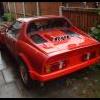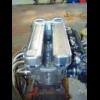I don't know what cc my A-series is. It's definitely an MG metro to start with and it's had some head work. I'm told it's a 1380, but it goes like a 1275. I'm gonna be selling it soon, so I need to know.
Is there any way I can measure the displacement without popping the head? There's nowt wrong with anything at the top end, so I don't want to disturb anything if I can help it.
Any ideas? I've thought about filling a bore with oil, turning the engine by hand, and catching what flows out of the spark plug hole- but how would I measure it accurately?

Measure Capacity Without Removing Head?
Started by
pantera2075
, Oct 31 2008 04:08 PM
7 replies to this topic
#1

Posted 31 October 2008 - 04:08 PM
#2

Posted 31 October 2008 - 04:30 PM
using a syringe maybe
#3

Posted 31 October 2008 - 04:34 PM
Head gasket set is between £5 - £10.
Take the head off as this will give you the condition of the bores etc??
Take the head off as this will give you the condition of the bores etc??
#4

Posted 31 October 2008 - 05:21 PM
you'll spend longer piddling around trying to calculate the volume than if you whip the head off
#5

Posted 31 October 2008 - 05:26 PM
Boroscope and see if you can read any part numbers on the piston crowns?!
In reality - get the head off!!
In reality - get the head off!!
#6

Posted 31 October 2008 - 05:49 PM
Ok I get the message. Are a series calculated by swept volume or by one of the other funnies?
#7

Posted 31 October 2008 - 05:58 PM
All stated engine capacities are swept volumes.
#8

Posted 31 October 2008 - 08:31 PM
Awww, I actually like the oil method you were suggesting. (I don't like disturbing cylinder heads either!)
If you do want to use the oil method, try this:
Take a compression tester with a flexible hose and screw-in spark plug hole adapter.
Disconnect the hose from the gauge.
Move the piston to the absolute bottom (BDC).
Fill the bore with motor oil using a funnel through the spark plug hole.
Screw in the disconnected compression gauge hose.
Use a syringe to continue filling the hose and bore (hold the hose "up" and make sure oil comes all the way to the top).
Put the free end of the compression gauge hose in a graduated cylinder and slowly turn the engine over by hand to pump the oil into the graduated cylinder. Read off the collected volume of oil. Repeat your test several times and average the results. When you're done, use the syringe through the spark plug hole to remove the remaining oil. Don't leave it behind. It will be messy but fun.
WARNING: Historical Trivia to Follow.
Thomas Edison was not a physicist, engineer, or scientist in the modern sense of the word. He was a gifted, creative, practical designer and tinkerer.
When his laboratories had finally figured out how to make light-bulbs last and he had staffed up with scientist and researchers to improve the product... one guy was tasked with determining the volume inside a light bulb. (After all... you need to know how much inert gas to put inside them). A mathematician spent weeks coming up with a complex equation to determine the volume. He proudly announced his results to Edison who was not impressed and asked how long the man had spent figuring this out. Edison then took the man into the lab where he picked up an open light bulb globe. Edison filled the globe with water and then poured the liquid into a graduated cylinder. In triumph he pointed to the cylinder and said "that is the volume inside a light bulb".
End Trivia Content
If you do want to use the oil method, try this:
Take a compression tester with a flexible hose and screw-in spark plug hole adapter.
Disconnect the hose from the gauge.
Move the piston to the absolute bottom (BDC).
Fill the bore with motor oil using a funnel through the spark plug hole.
Screw in the disconnected compression gauge hose.
Use a syringe to continue filling the hose and bore (hold the hose "up" and make sure oil comes all the way to the top).
Put the free end of the compression gauge hose in a graduated cylinder and slowly turn the engine over by hand to pump the oil into the graduated cylinder. Read off the collected volume of oil. Repeat your test several times and average the results. When you're done, use the syringe through the spark plug hole to remove the remaining oil. Don't leave it behind. It will be messy but fun.
WARNING: Historical Trivia to Follow.
Thomas Edison was not a physicist, engineer, or scientist in the modern sense of the word. He was a gifted, creative, practical designer and tinkerer.
When his laboratories had finally figured out how to make light-bulbs last and he had staffed up with scientist and researchers to improve the product... one guy was tasked with determining the volume inside a light bulb. (After all... you need to know how much inert gas to put inside them). A mathematician spent weeks coming up with a complex equation to determine the volume. He proudly announced his results to Edison who was not impressed and asked how long the man had spent figuring this out. Edison then took the man into the lab where he picked up an open light bulb globe. Edison filled the globe with water and then poured the liquid into a graduated cylinder. In triumph he pointed to the cylinder and said "that is the volume inside a light bulb".
End Trivia Content
1 user(s) are reading this topic
0 members, 1 guests, 0 anonymous users

















